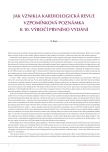-
Medical journals
- Career
Central blood pressure: how to improve the measurement of blood pressure in the 2nd century after Korotkoff
Authors: J. Špác
Authors‘ workplace: II. interní klinika LF MU a FN U sv. Anny
Published in: Kardiol Rev Int Med 2008, 10(1): 26-30
Overview
The measurement of blood pressure (BP) with sphygmomanometer cuff in the physician’s office remains as basal method, however there are pressure differences in the arterial system. Central BP in great arteries directly infl uencing the cerebral and coronary circulation may be different from BP measured over the brachial artery. In clinical praxis we dispose on noninvasive, proved and easily applicable equipment for estimation of central pressure, recording pulse waves over carotic or radial artery (so-called aplanation tonometry), or we only estimate elastic qualities of vessel wall by evaluation of pulse wave velocity. Various groups of antihypertensive drugs have different effect upon arterial compliance and through it upon central BP even when they infl uence the peripheral BP in the same way. So far we do not know if the parameters of central BP would substitute in the future the values of peripheral pressure from brachial artery and this question is the subject of further research.
Key words:
hypertension – properties of the arterial wall – blood pressure measurement
Sources
1. European Society of Hypertension-European Society of Cardiology Guidelines Committee. European Society of Hypertension–European Society of Cardiology guidelines for the management of arterial hypertension. J Hypertens 2003; 21(6): 1011–1053.
2. Protogerou AD, Papaioannou TG, Blacher J et al. Central blood pressure: do we need them in the management of cardiovascular disease? Is it a feasible therapeutic target? J Hypertens 2007; 25(2): 265–272.
3. Latham RD, Westerhof N, Sipkema P et al. Regional wave travel and reflections along the human aorta: a study with six simultaneous micromanometric pressures. Circulation 1985; 72(6): 1257–1269.
4. Murgo JP, Westerhof N, Giolma JP, Altobelli SA. Aortic input impedance in normal man: relationship to pressure wave forms. Circulation 1980; 62(1): 105–116.
5. O’Rourke MF, Nichols WW. Aortic diameter, aortic stiffness, and wave reflection increase with age and isolated systolic hypertension. Hypertension 2005; 45(4): 652–658.
6. Karamanoglu M, O’Rourke MF, Avolio AP, Kelly RP. An analysis of the relationship between central aortic and peripheral upper limb pressure waves in man. Eur Heart J 1993; 14(2): 160–167.
7. Davies JI, Struthers AD. Pulse wave analysis and pulse wave velocity: a critical review of their strengths and weaknesses. J Hypertens 2003; 21(3): 463–472.
8. Weber T, Auer J, O’Rourke MF et al. Increased arterial wave reflections predict severe cardiovascular events in patients undergoing percutaneous coronary interventions. Eur Heart J 2005; 26(24): 2657–2663.
9. Mattace-Raso FU, van der Cammen TJ, Hofman A et al. Arterial stiffness and risk of coronary heart disease and stroke: the Rotterdam Study. Circulation 2006; 113(5): 657–663.
10. Willum-Hansen T, Staessen JA, Torp-Pedersen C et al. Prognostic value of aortic pulse wave velocity as index of arterial stiffness in the general population. Circulation 2006; 113(5): 664–670.
11. Mäki-Petäjä K, Hall F, Booth A et al. Rheumatoid arthritis is associated with increased aortic pulse-wave velocity, which is reduced by anti–tumor necrosis factor-alpha therapy. Circulation 2006; 114(11): 1185–1192.
12. Roman MJ, Devereux RB, Schwartz JE et al. Arterial stiffness in chronic inflammatory diseases. Hypertension 2005; 46(1): 194–199.
13. Tropeano AI, Boutouyrie P, Pannier B et al. Brachial pressure-independent reduction in carotid stiffness after long-term angiotensin-converting enzyme inhibition in diabetic hypertensives. Hypertension 2006; 48(1): 80–86.
14. Williams B, Lacy PS, Tom SM et al.. Differential impact of blood pressure-lowering drugs on central aortic pressure and clinical outcomes: principal results of the Conduit Artery Function Evaluation (CAFE) study. Circulation 2006; 113(9): 1213–1225.
15. Laurent S, Cockcroft J, Van Bortel L et al. Expert consensus document on arterial stiffness: methodological issues and clinical applications. Eur Heart J 2006; 27(21): 2588–2605.
16. McEniery CM, Schmitt M, Qasem A et al. Nebivolol Increases Arterial Distensibility In Vivo. Hypertension 2004; 44(3); 305-310.
17. London GM, Asmar RG, O´Rourke M, Safar ME. Mechanism(s) of selective systolic blood pressure reduction after a low-dose combination of perindopril/indapamide in hypertensive subjects: comparison with atenolol. J Am Coll Cardiol 2004; 43(1): 92–99.
Labels
Paediatric cardiology Internal medicine Cardiac surgery Cardiology
Article was published inCardiology Review

2008 Issue 1-
All articles in this issue
- Speckle tracking echocardiography is a new, non-invasive method for the assessment of left ventricular global and regional function
- What is new in heart transplantation
- Aneurysm of the thoracic aorta
- Central blood pressure: how to improve the measurement of blood pressure in the 2nd century after Korotkoff
- Cardiology Review
- Journal archive
- Current issue
- Online only
- About the journal
Most read in this issue- Aneurysm of the thoracic aorta
- Speckle tracking echocardiography is a new, non-invasive method for the assessment of left ventricular global and regional function
- Central blood pressure: how to improve the measurement of blood pressure in the 2nd century after Korotkoff
- What is new in heart transplantation
Login#ADS_BOTTOM_SCRIPTS#Forgotten passwordEnter the email address that you registered with. We will send you instructions on how to set a new password.
- Career

